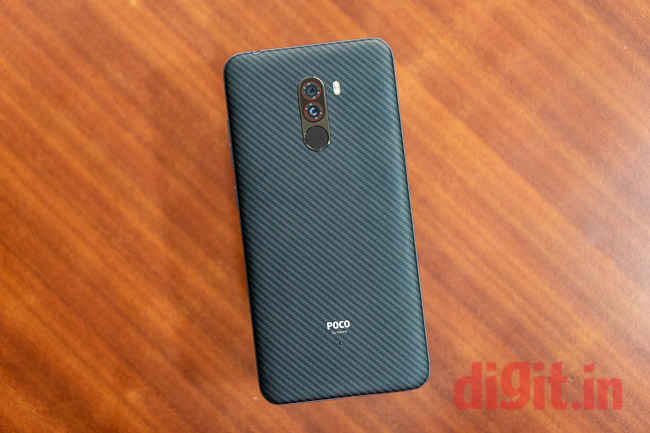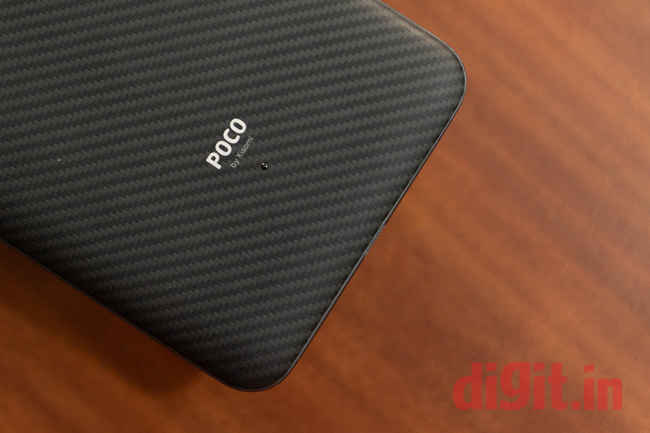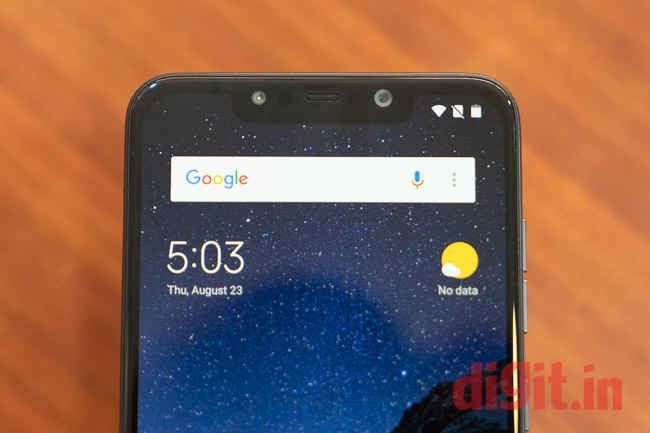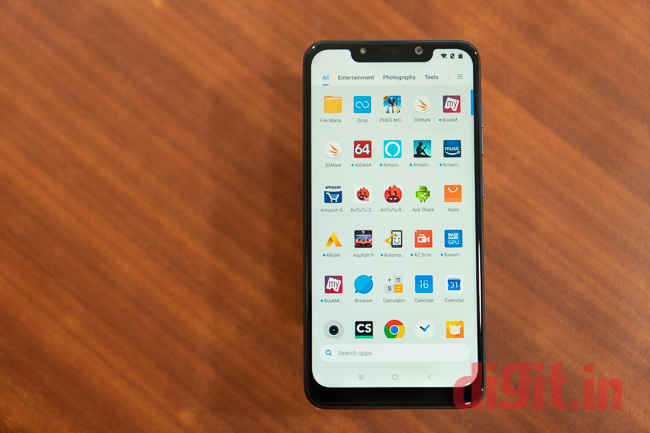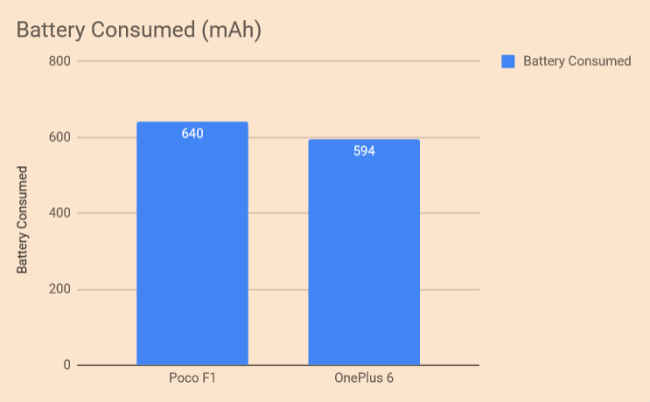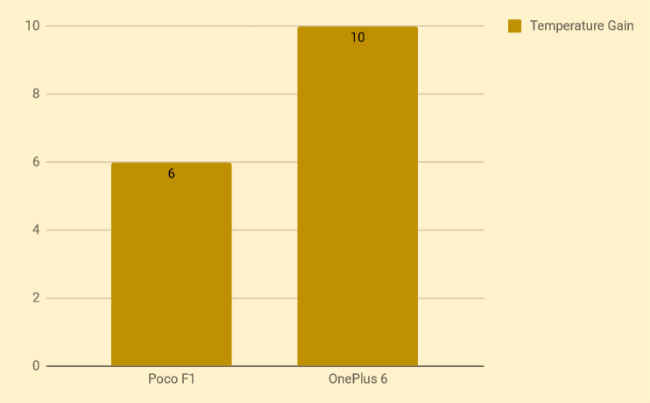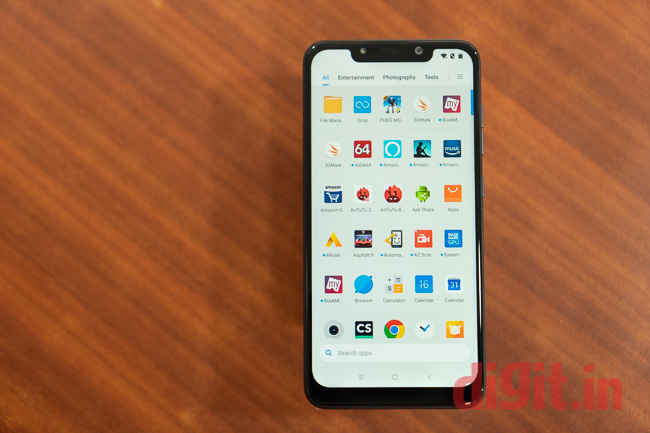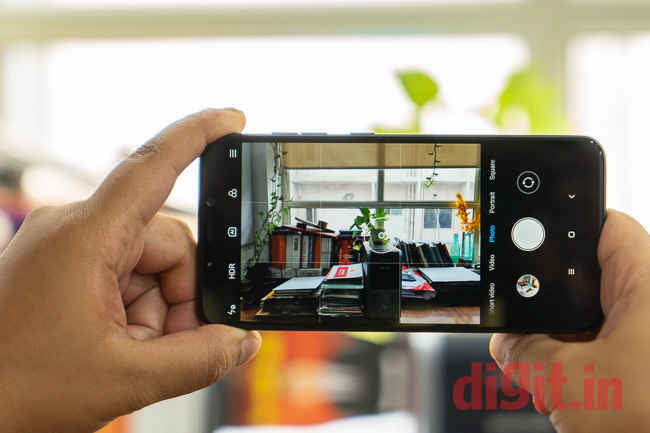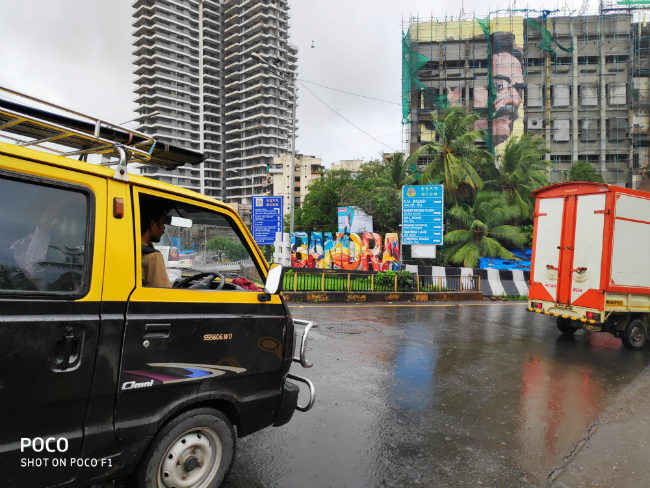Poco F1 Review : Flagship hardware in a mid-range package
The Poco F1 has flagship hardware under the hood, but mid-range everything else. The camera, build and design and the display can’t keep up with the more expensive flagships of 2018. However, if a no-nonsense performer is what you’re looking for on a budget, look no further. Know this that the software right now is riddled with bugs and the camera can’t hold a candle to say the Galaxy S9 or even the OnePlus 6. You do get a sturdy build that should last long, and perhaps the longest battery life on a Snapdragon 845-powered smartphone. At Rs 20,999 though, it can’t get any better.
The Poco F1’s focus is primarily on speed. And with a Qualcomm Snapdragon 845 chipset, speed is more or less guaranteed. But along with speed, people also demand a good enough camera and a design they can show off. The rivals Poco compared the phone with on stage at the launch, the OnePlus 6 and the Samsung Galaxy S9 Plus, have more or less all the elements of a flagship phone. A stunning glass design, an immersive display, reliable and consistent camera, and most importantly, a strong community of followers. The high-end hardware-touting Poco F1 definitely has the price in its favour, but is that enough for it to convince buyers to forget the stalwarts and go for this? Let’s find out.
Design and build
The Poco F1’s design is interesting. Instead of going for glass (which is brittle) or metal (which is common), it went for polycarbonate, or dense plastic for short. While that might make design connoisseurs cringe, it’s perfectly durable. Glass is brittle and tends to crack, while metal attracts scratches and dents. Even the frame is made of polycarbonate. The unit we received for review is the Armoured Edition that uses kevlar instead of plastic, but only on the back. It gives a nice texture to the body adding to the grip. It’s non-slippery as well but is prone to smudges and tend to retain dirt. The frame and the front are the same as other variants. There is a tiny spot right below the Poco logo on the back, that just stands out as odd. Poco says it’s a beauty spot, and most likely, it is an anomaly in the industrial design, but nothing that comes in the way of use. You get the option of red, blue and black colour variants. The design of the Poco F1 is pragmatic. It’s logical and for the target audience it’s aimed, it makes perfect sense. Thanks to a new sub-brand, Xiaomi was able to do things it couldn’t have done with the Redmi and the Mi lineup of phones otherwise. The use of polycarbonate is one. Imagine a high-end Mi phone with a plastic body when it already has a reputation of using materials like ceramic.
Having said that, the Poco F1 looks a lot like Xiaomi’s Mi 8 from the front, which in turn looks like the iPhone X, notch included. It’s a design choice we’ve come to accept in smartphones in 2018. The Poco F1’s notch is wide even for today’s standards. That’s because it houses a dedicated IR blaster along with the front camera to help face unlock work under low light conditions. Well, face unlock does work swiftly. Blazing fast almost and the IR blaster allows the phone to scan your face even before you turn on your phone at night. Interestingly, the Poco F1 isn’t using the notch to cut down on the bezels around the screen. The bottom chin is significantly big, and even the side bezels are relatively thick.
The phone has the typical rounded corners that are found in most Xiaomi phones. It’s quite compact as well, even though it’s not the slimmest phone by a mile thanks to the 4,000mAh battery it packs inside. The display is slightly raised from the body, and if I have to nitpick, that could be a weakpoint in the design. If the phone falls and lands on the edge, the display will be the most exposed. Otherwise, it’s still one of the more durable phones with a flagship processor, apart from the LG G7 ThinQ. Quite expectedly, there is no waterproofing, but Poco claims there is a water resistant coating on the body that repels water to a minimal extent. Water damage is not covered under warranty though I would suggest being careful around pools with this phone.
The Poco F1 is well built and can withstand wear and tear more than your average glass-back phones.
Display
The Poco F1 touts a 6.18-inch panel with a big, wide notch and hearty bezels all around. It’s an IPS LCD panel of FullHD+ resolution with a 19:9 aspect ratio. The pixel density is effectively 403 ppi which is on the lower side, when you compare it against flagships that have QHD displays and AMOLED panels. The display is perhaps the weakest part of the package. It’s just about functional. The panel is sufficiently bright to get the job done when indoors and outside under direct sunlight, colours tend to get washed out a bit, but not illegible. We got a reading of 389 lux in our display test. Compared to the OnePlus 6 or the Honor 10, which have really bright panels, this isn’t all that great.
Colour reproduction is more or less average, similar to what you would get on a mid-range phone. It’s not super saturated and vibrant, but just about functional. Xiaomi claims to have a contrast ratio of 1500:1 which is decent. The blacks aren’t that saturated though and if you choose to hide the notch, it’s easily visible even when you’re watching a video. YouTube and Netflix videos automatically adapt to the new aspect ratio, which is essentially leaving big black bars along the sides.
Xiaomi offers options to turn on the night mode (automatically), adjust the contrast and colour temperature, and the text size. You don’t have the option to switch colour gamuts like you can in the OnePlus 6. For someone looking for a colour accurate display, the Poco F1 is not for them. Which is how Xiaomi aka Poco has managed to bring down the price. The display comes off as one on a mid-range phone and not a high-end. High-end panels are costly and this is one way of cutting down on the bill of materials.
Performance
As of publishing this review, the popular benchmarking apps were locked down to prevent scores from leaking on the internet. We will update the review with benchmark scores once they are available.
The focus of the Poco F1 is solely on speed, a clear indication of who it wants to compete with. The Qualcomm Snapdragon 845 chipset is aided by a vapour-chamber cooling mechanism that Poco claims help in sustained peak performance. This is part of the phone’s tall claims of better real-life performance over other flagship phones and for the most part, it is fast. Whether it’s faster than the rest is something we, as reviewers, were prevented from testing. Some of the benchmark apps were locked down by Poco at the time of publishing this review, so we don’t have objective numbers to share with you claiming whether this is fast. I’d be inclined to give the Poco F1 the benefit of doubt considering there’s a dedicated cooling contraption in it, coupled with 8GB of RAM LPDD4X RAM and 256GB of UFS 2.1 storage in the unit we received for review.
Only AnTuTu worked and on that, the Poco F1 got the score of 265754, which is some 2000 points higher than OnePlus 6’s 244517. It’s literally the only objective number we had to compare the performance of the two devices.
In real-life, the Poco F1 is sufficiently fast, as you would expect from a phone powered by the Snapdragon 845. There are no apps currently to really stress out the chipset and any claims of sustained peak performance cannot really be measured. Even popular heavy-graphics titles like PubG Mobile don’t use full resources of the chipset for long, so it’s next to impossible to put Poco’s claim of having sustained peak performance to claim. You have to take their word for it.
Gaming performance
We did play PubG Mobile on both the OnePlus 6 and the Poco F1 to test the thermals. After 30 minutes of gaming, the Poco F1 registered external temperature of around 41.2 degrees (a climb from 34.9) while the OnePlus 6 registered 43.3 degrees (a rise from 32.9), indicating that the Poco F1 is thermally more stable as there was a rise of just 6 degrees as compared to 10 degrees in the case of OnePlus.
The Poco F1 also consumed more battery, of around 640mAh while the OnePlus 6 consumed around 594mAh after 30 minutes of gaming. It could be that the AMOLED panel on the OnePlus 6 is more power-efficient, hence the lower battery usage.
For those wondering about other real-life scenarios, the F1 is quite capable at handling tasks like editing photos, playing videos, switching between apps and generally power using the phone.
We are testing the performance of both the phones (and some other similarly priced phones) for an in-depth comparison which will be out by next week. Hopefully by then the benchmarks will be unlocked and we can have a clearer picture of the phone’s performance.
Software
Good performance requires two a key ingredients; a good operating system that is written to get the most out of the hardware package. A user will spend most amount of time with the UI and that’s one place where the speed can be felt in real time. The Poco F1 runs on a customised version of MIUI 9.5 based on Android Oreo 8.1. Poco’s choice of UI as compared to Xiaomi’s MIUI, is more attuned towards stock Android fans. It’s called the Poco launcher and Xiaomi will make it available for everyone to download off the Google Playstore on August 29th. The customisations are aimed at speeding up the experience using the phone, and you can actually feel how fast it is. The notification shade comes down quicker. The swipes and flicks are registered quicker. But the biggest offering for any enthusiast is perhaps the inclusion of the app drawer. On the 256GB variant of the phone, you’re bound to install a whole lot of apps and having an app drawer makes all your apps much more organised and accessible without cluttering the home screen. The app drawer is also categorised into different categories and you can sort apps by colours. The Poco launcher also supports custom icon packs, although it doesn’t have a theme engine of its own like MIUI.
Poco claimed at the launch there are some deep-system optimisations made to the software to make it the ‘master of speed’. In on-stage vidoes, it showed the UI is faster than the OnePlus 6 to open apps and even remember and prioritise the launch of important apps. Poco apparently has a dedicated memory channel that is used to fast-track app launches. The list of optimisation includes dynamic resource allocation, core congestion control, cache management, real-time defragmentation and more. These are optimisations that have given OnePlus’ OxygenOS a good name, and now, Poco is following a similar route.
However, the software itself is still a work in progress. Certain elements are riddled with bugs and there are instability issues. The notification icons don’t show up in the status bar and every time the phone pinged, I had to drag down the shade to see the notification. Furthermore, the volume buttons stopped working midway and I had to restart the phone to get them working again. Instagram crashed a few times while benchmark apps refused to run.
It’s not that the UI isn’t fast. Apps do launch and load within few milliseconds and carrier aggregration does work on the Poco F1. I managed to get around 8Mbps on my Jio SIM on the Poco F1 as compared to 5Mbps on the OnePlus 6. The phone supports Dual 4G standby as well as Dual VoLTE. Poco promises an update to MIUI 10 within a few weeks along with quarterly security updates and a promised upgrade to Android 9 Pie by Q4 2018.
Camera
While the Poco F1’s focus is on speed, people are paying more these days not just for higher performance, but also for a better camera. The F1 promises a lot in the camera department, but does it all work as advertised? The F1 packs a dual camera unit at the back — A 12MP IMX 363 sensor with a lens of f/1.8 aperture and a pixel pitch of 1.4um. This is coupled with a 5MP sensor that is only used to capture depth information. Up front is a 20MP sensor that relies on pixel binning to deliver clearer photos with more details with lesser noise under low light. It’s the same setup you find on the company’s flagship Mi 8 and Poco claims it used the Mi 8’s algorithms to optimise the F1’s camera. There’s also a healthy dose of AI. Using Snapdragon 845’s AI Engine, the camera can recognise 206 scenes across 25 categories. The AI icon changes to the scene recognition if the mode is working. The software essentially tunes the camera parameters based on what you’re shooting. These are the results:
Daylight
The Poco F1 is quite capable of taking good daylight shots. The camera can quickly recognise what you’re shooting and the filters it applies generally increase the contrast and saturation to make the photo more palatable. Even without the AI mode on, the photo comes out decently exposed with sharp, rich details.
AI Mode off
AI Mode On
While exposing for the dawn breaking, the details in the shadows are lost to a higher degree than usual. The HDR mode kicks in automatically, and in this case, it wasn’t much of help. However, the orange glow of the rising sun does look pleasing, as does the gradient of orange to blue in the sky.
However, as the photo above will tell you, the Poco F1 is quite at reproducing solid colours. The black and yellow cab of Bombay roads came out perfectly saturated and actually looks pleasing. So is the BANDRA art installation on the road. It’s at a distance (taken from a speeding auto), but pixel peeping will tell you the details are well-preserved. Overall, daylight performance is certainly quite impressive.
Indoors
From the samples above, the Poco F1 is clearly adept at taking good shots indoors as well, provided the lighting is optimal. Straight lines are preserved with commendable sharpness and exposure and dynamic range is optimal. However, since there is no stablisation while shooting photos, one needs to have steady hands. Otherwise, you will get results like this:
Lowlight
A smartphone’s lowlight photo capabilities ultimately become the decider considering performance and other hardware are now more or less saturated. There are few smartphones that are good at taking low-light shots. The Google Pixel 2 is of course the category leader, followed by the Galaxy flagships. All of them are quite expensive as compared to the Poco F1. However, at the launch, Poco claimed the camera can take good low-light shots.
Well, this is what we got:
AI Mode Off
AI Mode On
The first sample had the AI mode turned off. The camera actually took some time to focus and shoot, but there was significant loss in details. The light sources (even the ones that are nearer) are not in focus. The surface of the buildings are softened, while the shadow regions are lacking in details. With the AI mode on, the photo did come out a little brighter, but it also brought also a lot more noise. The AI did manage to recover some details from the shadow regions, but the lights are similarly out of focus.
Even when taking photos of closer objects under low-light, there are some visible softening in place. The exposure isn’t all that bad though and the first sample is adequately saturated with vibrant colours. The noise does creep in the area around the sky. In the second sample, the red rods of the tower is once again softened. In reality, they were much more shiny. The complex straight lines are well-captured though.
Portraits
This is a mode that works well, as promised. Xiaomi’s bokeh algorithms are known to be good at churning out consistent bokeh shots. In this case too, bokehs work well enough. It’s not very aggressive and the edges don’t lose out on the details while blurring. In fact, the area under focus is well reproduced as well.
Battery
Completing the package is a 4,000mAh battery. It’s in fact the only phone with Snapdragon 845 with that big a battery right now. Poco promised over a day’s worth of usage from the F1. As mentioned before, the benchmark apps are under lockdown and we couldn’t perform our battery test to objectively test the battery life.
In real-life though, upon using the phone as a daily driver for a few days, it’s easy to see Poco’s claims standing tall. The 4,000mAh battery lasted easily around a day of heavy usage with ample use of the camera, mobile data, social media browsing, watching Netflix and more. It seems to live up to the promise of a long battery life and that is good news for speed junkies who don’t always have a plug point nearby.
Bottomline
The Poco F1 is an interesting device. It’s a good attempt at being a flagship phone under the hood. The chipset, RAM and storage are all at par with the most powerful Android device right now. However, certain trade-offs and compromises keep the F1 from becoming the true flagship killer. Corners were cut in the design. There’s no waterproofing. The Gorilla Glass on top of the panel is an outdated Gorilla Glass 3. The display has a lot of bezels around it and isn’t the best in the game. The software too isn’t perfect and some bugs still need to be ironed out. It’s promise of speed stands tall mostly, but since we were abstained from performing benchmarks, a definitive verdict is missing. Thermal performance is definitely better which should impress mobile gamers, and so is the real-world performance of the phone.
However, a flagship phone, by definition, embodies the best a company has to offer. If this is indeed the best Poco can do, it leaves a lot to be desired. The F1 is certainly value for money for those who simply demand speed, both on paper and in real-life. But anyone asking for anything more – A better camera, premium design and regular updates will have to look elsewhere. It is certainly the cheapest phone with a flagship processor, but standing in 2018, a flagship processor does not make it a flagship device.
Keeping those constraints in mind, the Poco F1 is a flagship-level performer in a mid-range offering. Everything except the raw performance is mid-range. For Rs 29,999, you also get the Asus Zenfone 5z while happens to run the same flagship chipset, offer a more premium design and has a lot of baked-in AI capabilities along with offering an impressive camera. The OnePlus 6 (the top variant of which retails for Rs 44,999) has a better camera and an active community of users and developers have made the OnePlus 6 the enthusiast’s phone of choice.
If you need to upgrade from the Redmi Note 5 Pro to a more powerful device, the base variant of the Poco F1 does make a lot of sense. Otherwise, if you can afford the more expensive OnePlus 6, Asus Zenfone 5z or even the LG G7 ThinQ (which is even better), you’ll be better off with an overall better experience.

